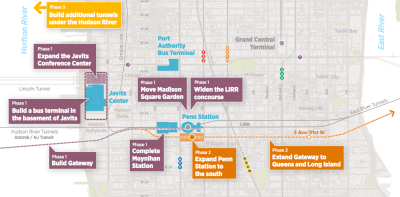RPA: Growing Outer Boroughs Need New Generation of Transit Investment
![Subways, focused on service to and from the Manhattan core, have seen a 23 percent ridership boost since 2003. Over the same period, bus ridership, which forms the backbone of outer-borough transit, has fallen 6 percent. Image: RPA [PDF]](http://www.streetsblog.org/wp-content/uploads/2015/02/buses_not_keep_up_outerboro_growth.png)
With the boroughs outside Manhattan adding people and jobs faster than the city core, New York needs to reorient its transit priorities, argues the Regional Plan Association in a new report. The authors warn that increasing travel in the other boroughs will strain the local bus system and lead more people to drive, causing more traffic congestion and imposing the burden of car ownership on more low- and middle-income New Yorkers.
This trend is already apparent. You could call it a tale of two trips.
Trips to and from the Manhattan core are shifting away from cars, with almost 90 percent of commuters to jobs below 60th Street arriving by transit. Subways, the backbone of the network into and out of Manhattan, have seen ridership increase 23 percent since 2003. Major projects are underway to extend subways and commuter rail serving the Manhattan central business district.
By comparison, transit trips that don’t begin or end in Manhattan are slower and less convenient, and they’re getting worse.
While the region may be centered around the Manhattan core, the lives of many New Yorkers are not: 61 percent of NYC workers who live outside Manhattan also work outside Manhattan. Over the last two decades, the number of jobs in the other boroughs has grown twice as fast as Manhattan-based jobs. At the same time, buses — the workhorse of outer-borough travel — have seen ridership fall 7 percent since 2003.
To avoid a future of even more sluggish transit and congested streets, RPA suggests new rail connections, more Bus Rapid Transit lines, and improving access to existing commuter rail service for city residents.
The report’s headline recommendation is the Triboro Rx, a circumferential rail line from the Bronx to Brooklyn first proposed by RPA in the 1990s. Connecting to subway service at 12 of its 22 stations, the service would use existing rail lines forming a “U” shape across southern and eastern Brooklyn before connecting through Queens and the Hell Gate Bridge. Instead of terminating in the South Bronx like previous Triboro Rx proposals, the latest iteration would use planned Metro-North stations along the Hell Gate Line to Co-Op City. RPA estimates the Triboro Rx would attract 100,000 riders daily.

A second opportunity for expanded rail service is along Atlantic Avenue. Once East Side Access diverts more trains to Manhattan, LIRR plans to use the line as a shuttle between Downtown Brooklyn and Jamaica. The report suggests combining the Atlantic Branch with improvements to the Rosedale section of the Montauk Branch to improve transit to eastern Queens. The report also calls for a third track on the LIRR main line to allow more reverse commute trains during peak hours, as well as reactivation of rail service on the Rockaway Beach Branch.
The report notes that much can also be done with existing commuter rail services to better meet the needs of outer-borough residents. Suburban trains often skip stations in Queens and the Bronx, and high fares dissuade many customers. RPA suggests more frequent service to outer-borough stations and expanding the half-price CityTicket program from weekends to weekdays, which it says will cost the MTA $30 million annually.
To improve bus service, RPA suggests fixing existing routes first. The organization identified 56 bus routes with infrequent service and another 36 that are overcrowded, and recommends adding service to these lines at an operating cost of $28 million a year.
RPA also mapped out nine routes for Select Bus Service and urged more robust transitways than the city has deployed on the current generation of SBS routes, with features like physically separated lanes. The work echoes proposals from the Pratt Center and the MTA itself, with lines traversing parts of the outer boroughs where subway connections are difficult or impossible.
One transit mode absent from RPA’s recommendations: ferries. “The City plans to identify additional ferry services that will all almost certainly require subsidies,” the authors write.
The report only backs ferry service to the Rockaways, because the area is so isolated, and is deeply skeptical that other routes are worth the cost. It singles out a ferry from Soundview in the Bronx, one of Mayor Bill de Blasio’s proposed routes, for criticism. “Its prospects are questionable without substantial subsidy,” the report says. “If it is initiated, it should be clear that it must meet the ‘use it or lose it’ demonstration criteria.”



